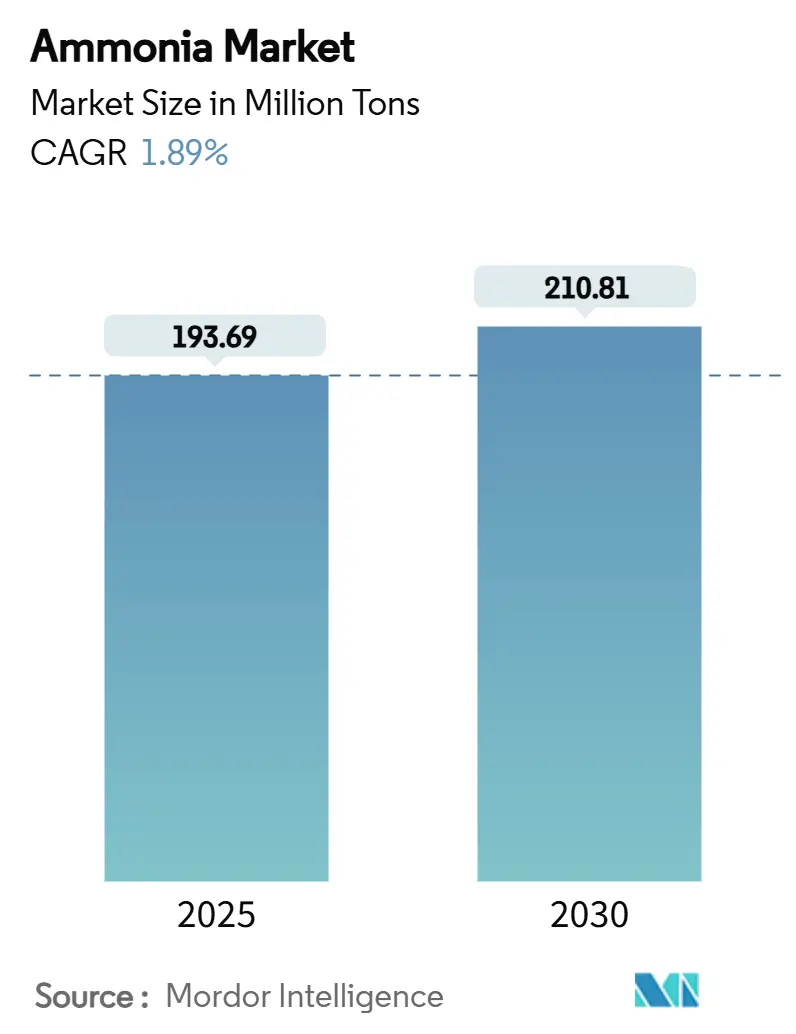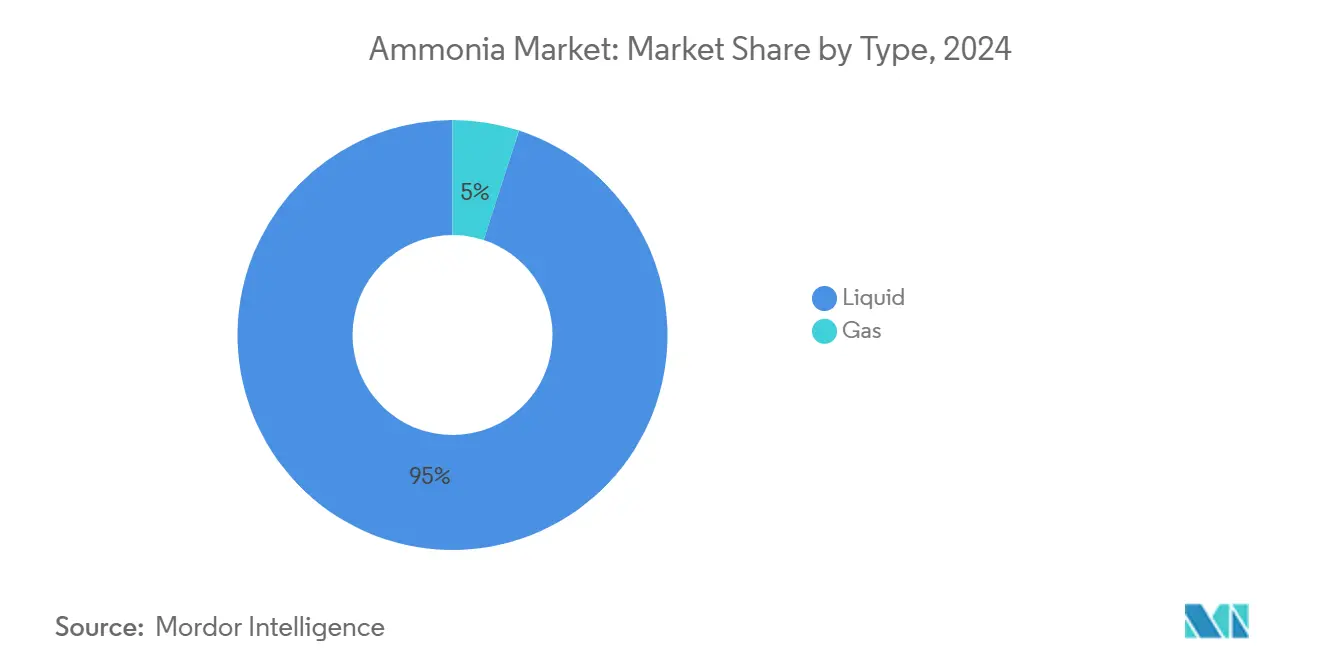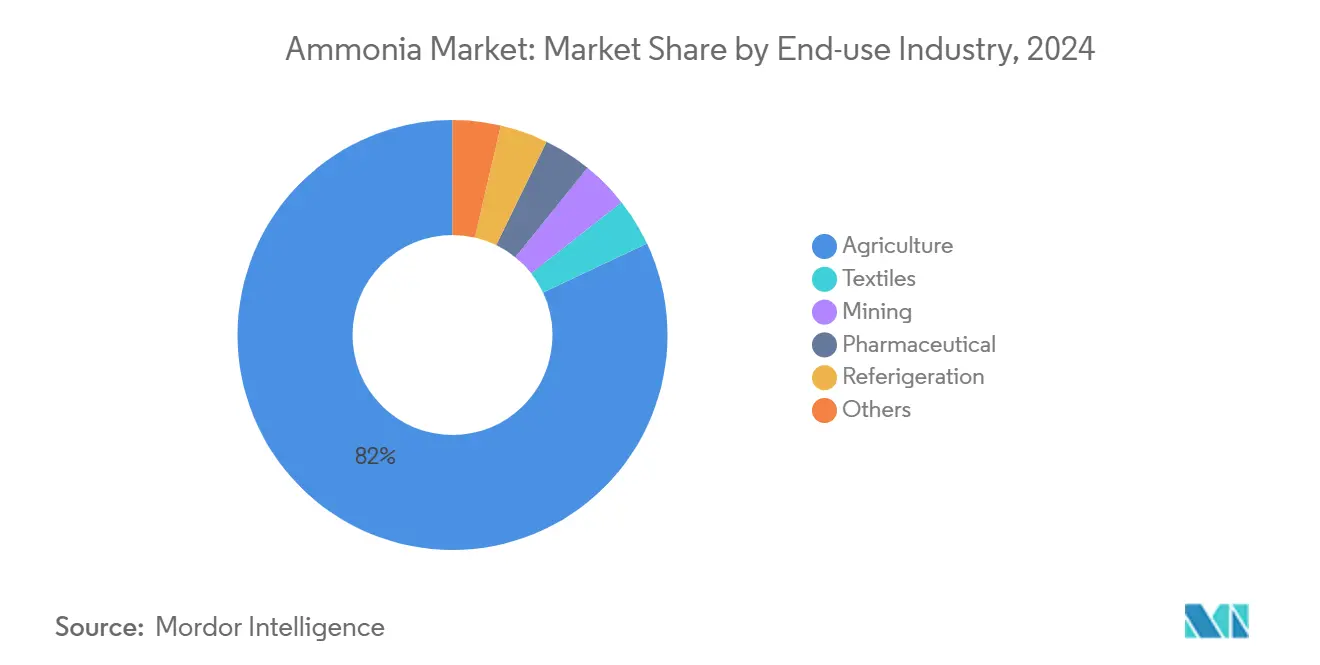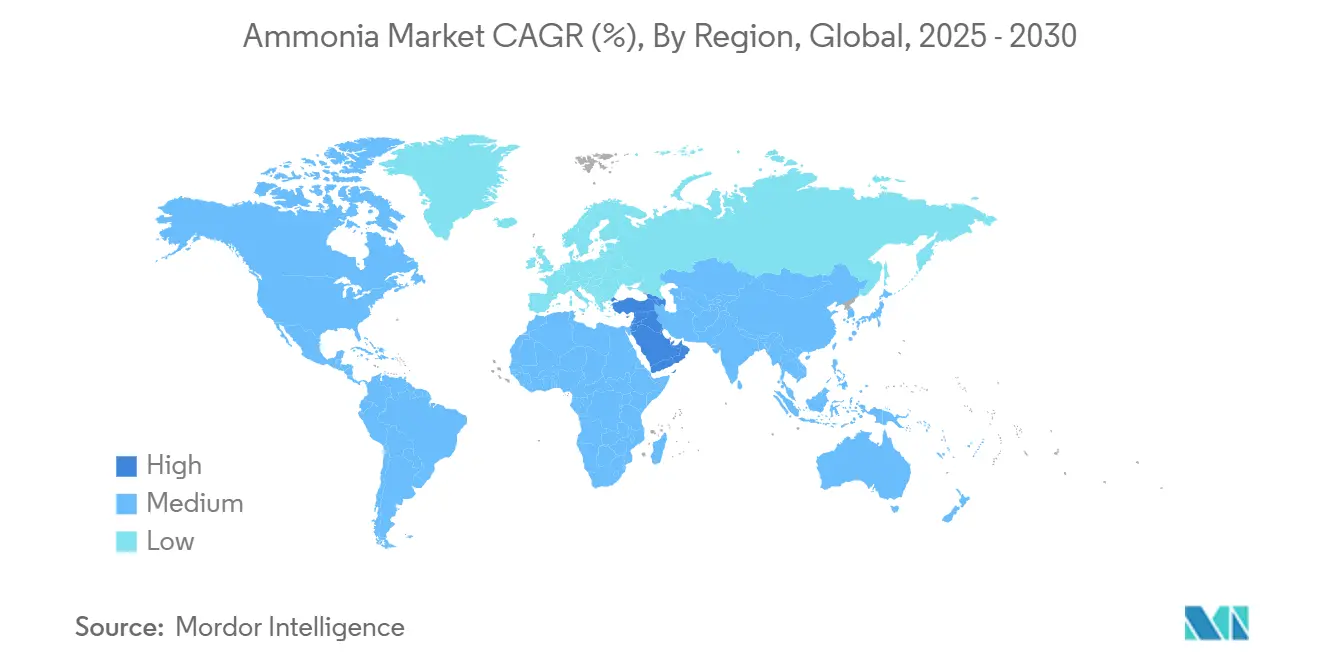Ammonia Market Size and Share

Ammonia Market Analysis by Mordor Intelligence
The Ammonia Market size is estimated at 193.69 Million tons in 2025, and is expected to reach 210.81 Million tons by 2030, at a CAGR of 1.89% during the forecast period (2025-2030). This steady topline belies a fundamental transition in production technologies, feedstock strategies, and downstream uses as decarbonization targets tighten, natural-gas price volatility persists, and low-carbon maritime fuels gain traction. Strategic investments in green and blue facilities, coal-to-gas upgrades in China, and the emergence of ammonia as a hydrogen carrier are repositioning supply chains, while rising safety requirements and urea oversupply keep short-term prices volatile. Producers able to lock in low-carbon feedstocks, secure renewable power, and form technology alliances are improving cost competitiveness, whereas Europe’s gas-exposed assets remain under margin pressure. As these structural forces reshape the ammonia market, regional growth rates, product mixes, and trade flows are diverging more sharply than headline tonnage suggests.
Key Report Takeaways
- By type, liquid product dominated with 95% revenue share in 2024 and is poised to expand at a 1.94% CAGR to 2030.
- By application, nitrogen fertiliser accounted for 78% share in 2024, while refrigerants commanded the highest growth at 3.10% annually (2025-2030), outpacing fertilizer intermediates.
- By end-use industry, agriculture accounted for 82% of the ammonia market size in 2024 and is forecast to grow at a 1.99% CAGR through 2030.
- By geography, Asia-Pacific held 51.40% of the ammonia market share in 2024, while the Middle East and Africa region is projected to post the fastest 2.67% CAGR through 2030.
Global Ammonia Market Trends and Insights
Drivers Impact Analysis
| Driver | (~) % Impact on CAGR Forecast | Geographic Relevance | Impact Timeline |
|---|---|---|---|
| Surge in Low-Carbon Fertiliser Demand across Asia | +0.60% | Asia-Pacific | Medium term (2-4 years) |
| Ammonia Adoption as Hydrogen Carrier for Maritime Bunkering in Japan & South Korea | +0.40% | Japan, South Korea, global hubs | Long term (≥ 4 years) |
| Coal-to-Gas Conversion of Chinese Urea Plants Boosting Ammonia Off-take | +0.30% | China | Short term (≤ 2 years) |
| Increasing Usage to Produce Explosives | +0.20% | Australia, South America, Africa | Medium term (2-4 years) |
| Rising Demand for Green Ammonia | +0.70% | Global, with concentration in Europe, Middle East, and Australia | Long term (≥ 4 years) |
| Source: Mordor Intelligence | |||
Surge in Low-Carbon Fertiliser Demand across Asia
Asia’s agricultural pivot toward sustainability is accelerating low-carbon fertilizer uptake. China is upgrading coal-based assets with renewable electricity and carbon-capture systems, lifting demand for renewable ammonia blends. Indonesia’s GAIA project introduces the first hybrid plant that co-feeds natural gas and electrolytic hydrogen, providing a scalable template for transition facilities. Policy incentives, such as preferential loan programs for sustainable inputs and tighter emission limits on conventional urea plants, are nudging farmers to premium products. The ripple effect is already evident in equipment orders for modular electrolysers and in long-term offtake contracts between fertilizer distributors and renewable electricity developers.
Adoption as Hydrogen Carrier for Maritime Bunkering
The maritime sector’s decarbonization pledge is positioning ammonia as a practical hydrogen vector. Japan and South Korea completed the world’s first truck-to-ship bunkering operation in 2024, demonstrating end-to-end handling safety and reinforcing confidence among port authorities[1]Offshore Energy, “JERA and NYK Complete World’s First Truck-to-Ship Ammonia Bunkering,” offshore-energy.biz . The International Maritime Organization's target to halve shipping emissions by 2050 has motivated carriers to lock in green ammonia supply agreements. Class-society approvals for ammonia-ready engines and the rollout of coastal carrier designs are lowering technical risk, while carbon-price forecasts improve project economics.
Coal-to-Gas Conversion of Chinese Urea Plants
Substituting coal with natural gas in Chinese urea complexes offers immediate carbon-intensity relief. Projects such as Ningxia Coal Industry’s USD 1.8 billion revamp cut CO₂ emissions by 2.20 million tons annually and free up incremental ammonia volumes for merchant sales[2]Ningxia Coal Industry Company, “MTP Revamp Project Enters Field Construction Stage,” asiachem.org . The efficiency improvement, applied across assets representing nearly one-third of global capacity, equates to a potential 3-4 million ton supply boost. The transition is financially incentivized by regional CO₂-trading schemes that monetize avoided emissions.
Increasing Usage to Produce Explosives
Ammonium nitrate demand is rising alongside elevated mining activity in Australia, South America, and Africa. As miners expand iron ore and battery-metal projects, consumption of blasting agents built on ammonia feedstock follows suit. Because explosives demand moves counter-cyclically to fertilizer cycles, producers are diversifying revenues and reducing seasonal throughput swings[3]CAS, “Ammonium Nitrate: Making It Safer Today,” cas.org .
Restraints Impact Analysis
| Restraint | (~) % Impact on CAGR Forecast | Geographic Relevance | Impact Timeline |
|---|---|---|---|
| Volatile Natural-Gas Prices Inflating European Production Costs | -0.50% | Europe | Short term (≤ 2 years) |
| Safety & Toxicity Concerns Slowing its usage across various industries | -0.30% | Global | Medium term (2-4 years) |
| Urea Over-supply Suppressing Spot Ammonia Demand | -0.30% | Global, with concentration in major agricultural markets | Short term (≤ 2 years) |
| Source: Mordor Intelligence | |||
Volatile Natural-Gas Prices Inflating European Production Costs
European producers face chronic cost inflation as natural-gas spot prices remain above pre-2022 levels. Several plants operated by CF Industries and BASF have curtailed output, removing up to 7 million tons of effective capacity. Imports of Russian urea are back-filling the gap, complicating regional policy goals. Unless energy-sourcing contracts lock in competitive prices or blue-ammonia retrofits proceed swiftly, European supply is expected to lag global demand.
Safety & Toxicity Concerns
Ammonia’s toxicity requires rigorous containment. Studies warn that large-scale fuel combustion could increase fine-particulate exposure, potentially causing substantial health impacts in densely populated port cities. Industrial leaks, such as the 47 releases at US food-processing plants during 2012-2021, keep regulators attentive. Additional investment in double-walled tanks, scrubbers, and crew training elevates project capex and may delay facility commissioning.
Segment Analysis
By Type: Liquid Dominates with Versatility Advantage
Liquid product accounted for 95% of the ammonia market tonnage in 2024. This form benefits from higher volumetric energy density than compressed hydrogen, facilitating cost-effective storage for maritime bunker suppliers and long-distance pipeline blends. The segment is forecast to grow at 1.94% annually, slightly faster than the overall ammonia market, as new port bunkering hubs, on-site refrigeration systems, and specialized coastal carriers come online. Technological advances, including Japan’s large-coastal-carrier prototypes, support larger parcel sizes that reduce delivered cost per ton. Investments in cryogenic insulation and detection systems mitigate boil-off losses, further reinforcing liquidity advantages.
The gaseous segment remains essential for processes requiring immediate gasification, such as certain polymer or caprolactam syntheses, yet its share is constrained by higher handling costs. Safety regulations limit transport pressures and demand thicker-walled cylinders, which inflates logistics expenses relative to refrigerated-liquid shipping. Although incremental growth is expected in niche petrochemical processes, liquid product will continue to dominate the ammonia market through 2030.

Note: Segment shares of all individual segments available upon report purchase
By Application: Refrigerants Outpace Traditional Uses
Ammonia refrigeration captured a smaller share than fertilizer intermediates in 2024, yet it is growing fastest at 3.10% CAGR. Environmental policies phasing out hydrofluorocarbons drive the switch to natural refrigerants. Industrial systems using ammonia deliver up to 20% higher full-load efficiency and benefit from feedstock that can cost one-tenth of synthetic alternatives. Cold-chain operators, food processors, and petrochemical storage terminals are commissioning large ammonia cascade systems, spurring compressor and heat-exchanger upgrades.
Nitrogen-fertilizer intermediates retained 78% of the ammonia market size in 2024 because agriculture remains an essential demand pillar. Pharmaceutical synthesis, explosives, and emerging bunker-fuel blends diversify the use portfolio, buffering producers against agricultural price swings. Development of small-scale ammonia turbines and internal-combustion retrofits can broaden the downstream mix beyond 2030, yet refrigerant demand will remain the most dynamic application sub-segment.
By End-Use Industry: Agriculture Maintains Dominance Despite Diversification
Agriculture held an 82% share of total offtake in 2024 and is projected to expand at 1.99% CAGR through 2030 as population growth and diet shifts sustain fertilizer use. Precision-application tools, improved urea coatings, and regenerative-agriculture practices may optimize nitrogen efficiency, but acreage expansion in Africa and Southeast Asia underpins absolute tonnage growth. Renewable-ammonia adoption enables producers to align with low-carbon food-supply pledges, keeping the sector structurally important.
Non-agricultural demand continues to broaden, with refrigeration installations accounting for the quickest unit growth and mining explosives providing an anticorrelated revenue stream. Pharmaceutical and textile uses maintain stable baselines. Small yet promising demand pockets are forming in water-treatment additives and distributed energy-storage systems that leverage ammonia’s energy density. These trends collectively support a more balanced ammonia market portfolio over time.

Note: Segment shares of all individual segments available upon report purchase
Geography Analysis
Asia-Pacific dominated the ammonia market with 51.40% share in 2024. China’s coal-to-gas revamps and India’s 750-ton-per-day Hygenco project expand low-carbon capacity, while Japanese and South Korean ports pioneer bunkering pilots. Regional policy packages offering renewable-power wheeling and tax rebates further lower delivered costs. Indonesia’s hybrid plant in Aceh showcases transition pathways suited to resource-rich, power-constrained locations.
The Middle East and Africa region is the fastest-growing geography with a 2.67% CAGR projected for 2025-2030. Egypt’s USD 33 billion deal pipeline, Morocco’s billion-dollar Dakhla project, and Qatar’s USD 1.2 billion brownfield expansion illustrate sovereign ambitions to monetize solar and wind resources through green or blue ammonia exports. Gulf Coast engineering firms and shipyard alliances provide technical expertise, accelerating construction timelines.
North America leverages abundant shale gas and carbon-capture hubs to keep marginal production costs low. CF Industries’ 10.4 million-ton capacity and 37 US project proposals could raise regional output from 21 million to 79 million tons annually if sanctioned. Federal clean-hydrogen tax credits improve economics for blue facilities, and Gulf Coast ports offer deep-water access to European and Asian markets.
Europe wrestles with high gas prices and uncertain carbon-border tariffs. Production curtailments continue as spot prices remain volatile, though technology providers are accelerating blue-ammonia retrofits with up to 99% CO₂ capture rates. Import dependence is rising, highlighted by increasing Russian urea inflows. Although the European Union seeks to promote domestic energy security, capital allocation favors downstream clean-fuel offtake agreements more than new indigenous capacity.
Latin America and Oceania add incremental growth through mining and bunker-fuel demand. Brazil’s Port of Açu reserves land for a 1 million-ton green-ammonia facility, while Australia’s iron-ore expansion drives explosives consumption.

Competitive Landscape
The global ammonia market is moderately fragmented, with the top five producers controlling less than 35% of installed capacity in 2024, indicating moderate concentration. CF Industries leads output with 10.4 million tons and capitalizes on low US gas prices. Yara International follows with 6.4 million tons and a diversified portfolio spanning Europe, Africa, and North America, now supplemented by US Gulf Coast greenfield plans targeting up to 1.4 million tons per plant. Nutrien, OCI, and SABIC round out the leading group with regionally balanced footprints.
Strategic alliances are redefining competitive edges. Johnson Matthey and thyssenkrupp Uhde offer an integrated blue-ammonia solution capturing up to 99% of process CO₂, appealing to asset owners in the US and Middle East. CF Industries and JERA jointly assess a Louisiana greenfield site to secure Japanese offtake. Technology partnerships between compressor manufacturers, electrolyser suppliers, and logistics firms accelerate time-to-market for first-mover projects and create cross-border synergies.
Energy majors are entering the ammonia market to diversify revenue and hedge against oil-price cycles. Equinor, BP, and TotalEnergies are co-funding large green-ammonia complexes with renewable developers, leveraging trading arms to manage offtake risk. Commodity traders such as Trafigura and Mitsui are booking terminal slots in anticipation of liquid-ammonia shipping growth. As low-carbon certification schemes gain traction, value migrates to firms that can verify emissions intensity and integrate upstream power contracting with downstream distribution.
Ammonia Industry Leaders
-
CF Industries Holdings Inc.
-
Nutrien
-
OCI
-
SABIC
-
Yara
- *Disclaimer: Major Players sorted in no particular order

Recent Industry Developments
- May 2024: CF Industries and Topsoe have announced a collaboration on a U.S.-based low-carbon ammonia project, aiming to enhance domestic production capacity while reducing emissions. This initiative is expected to strengthen the ammonia market by promoting sustainable practices and meeting the growing demand for low-carbon solutions.
- May 2024: Yara International has enhanced its presence in Asia by entering into an ammonia supply agreement with an Indian energy company. This strategic partnership is expected to strengthen the regional ammonia market by ensuring a stable supply chain and fostering increased collaboration within the industry.
Research Methodology Framework and Report Scope
Market Definitions and Key Coverage
Our study defines the global ammonia market as the total annual production and first sale of anhydrous and aqueous ammonia, whether liquefied for bulk transport or gaseous for on-site injection, used across fertilizers, explosives, refrigeration, textiles, pharmaceuticals, mining, and emerging energy carrier applications. According to Mordor Intelligence, this universe amounted to 193.69 million tons in 2025.
Scope Exclusion: Downstream derivatives (urea, ammonium nitrate, ammonium sulfate), niche "green" or "blue" ammonia value additions, and captive consumption of synthesis gas that never leaves integrated petrochemical complexes are not counted.
Segmentation Overview
- By Type
- Liquid
- Gas
- By Application
- Nitrogen Fertiliser Intermediate
- Refrigerants (Industrial and Cold-Chain)
- Explosives and Mining Nitrates
- Pharmaceutical Intermediates
- Others (Cleaning and Household Products and Marine Bunker Fuel / Hydrogen Carrier)
- By End-use Industry
- Agriculture
- Textiles
- Mining
- Pharmaceutical
- Referigeration
- Others (Food and Beverage, Rubber, Water Treatment, Petroleum, and Pulp and Paper Industries)
- By Geography
- Asia-Pacific
- China
- India
- Japan
- South Korea
- ASEAN
- Australia
- New Zealand
- Rest of Asia-Pacific
- North America
- United States
- Canada
- Mexico
- Europe
- Germany
- United Kingdom
- France
- Italy
- Spain
- Nordics
- Rest of Europe
- South America
- Brazil
- Argentina
- Rest of South America
- Middle East and Africa
- Saudi Arabia
- United Arab Emirates
- Qatar
- Turkey
- South Africa
- Egypt
- Nigeria
- Rest of Middle East and Africa
- Asia-Pacific
Detailed Research Methodology and Data Validation
Primary Research
Structured interviews and short surveys with plant operators, fertilizer distributors, maritime fuel developers, and process licensor experts across Asia-Pacific, North America, Europe, and the Middle East test desk research assumptions, surface unreported shutdowns, and calibrate average selling prices and utilization factors.
Desk Research
Mordor analysts first map global supply using publicly available producer capacity lists from the International Fertilizer Association, plant-level production data from the US Geological Survey and China's National Bureau of Statistics, and cross-border trade records extracted from UN Comtrade and Eurostat Comext. Policy notes from the International Energy Agency, patent families mined via Questel, and price trends from S&P Global Commodity Insights enrich the demand story with cost and technology signals.
Company 10-Ks, investor decks, customs filings, and credible press releases then refine regional feedstock costs, operating rates, and announced low-carbon projects. The sources cited above are illustrative; numerous additional open datasets are reviewed before figures are approved.
Market-Sizing & Forecasting
A top-down production plus trade reconstruction yields the 2025 baseline; selective bottom-up checks, capacity roll-ups, and sampled free-on-board price multiplied by merchant tonnage validate totals. Key model levers include natural gas cost spreads, regional capacity additions, fertilizer application rates per hectare, merchant ammonia trade flows, and anticipated bunker fuel trials. Forecasts to 2030 apply multivariate regression blended with ARIMA smoothing, with scenario ranges vetted by interviewed experts. Any data voids, such as undisclosed maintenance outages, are bridged with three-year moving averages that are re-scored during peer review.
Data Validation & Update Cycle
Outputs face variance tests versus historic price volume elasticities, peer review by a senior analyst panel, and a second pass before client release. The model is refreshed annually, while material events, such as gas price shocks and large plant start-ups, trigger interim updates.
Why Mordor's Ammonia Baseline Earns Decision-Maker Trust
Published figures often diverge because firms choose different units, include or exclude merchant trade, or freeze currency assumptions at varied dates.
Key gap drivers we observe are: some studies mix value and volume without clarifying conversions; others embed derivatives or green ammonia projects still under construction; a few apply single region price averages, ignoring feedstock disparities that Mordor's model adjusts quarterly.
Benchmark comparison
| Market Size | Anonymized source | Primary gap driver |
|---|---|---|
| 193.69 million tons (2025) | Mordor Intelligence | - |
| USD 235.14 billion (2025) | Global Consultancy A | Uses list price averages, counts urea and nitrate values inside headline figure |
| USD 79.47 billion (2024) | Regional Consultancy B | Excludes merchant export volumes and applies conservative ASP tied to Henry Hub only |
| USD 84.52 billion (2025) | Industry Association C | Treats captive integrated output as outside scope, leading to lower base |
The comparison shows how unit of measure, inclusion rules, and price anchors can shift totals by more than a factor of two.
By basing estimates on verifiable production data, transparent assumptions, and continuous refresh cycles, Mordor Intelligence delivers a balanced, repeatable baseline that planners can rely on with confidence.
Key Questions Answered in the Report
What is the projected size of the ammonia market by 2030?
The ammonia market is forecast to reach 210.81 million tons by 2030, growing at a 1.89% CAGR over 2025-2030.
Which region will grow fastest in the next five years?
The Middle East and Africa region is expected to post the highest regional CAGR of 2.67% between 2025 and 2030, driven by large-scale green-ammonia investments.
Why is ammonia gaining interest as a maritime fuel?
JERA and NYK’s successful bunkering trials, coupled with International Maritime Organization emission targets, position ammonia as a viable hydrogen carrier for decarbonizing shipping.
How are high European gas prices affecting ammonia producers?
Elevated gas costs have forced several European plants to curtail output, shifting import patterns and reducing regional supply competitiveness.
Which application segment is expanding fastest?
Refrigeration uses are growing at 3.10% annually due to regulatory phase-outs of hydrofluorocarbon refrigerants and ammonia’s superior thermodynamic efficiency.
What safety measures are critical for new ammonia projects?
Double-walled storage, continuous leak detection, crew training, and adherence to emerging emission standards are essential to mitigate toxicity risks in production, transport, and bunkering.
Page last updated on:



